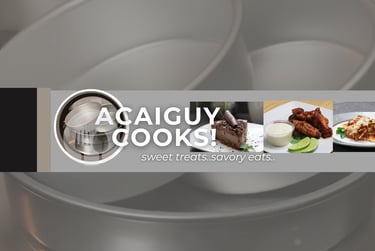Science of Cookware
When it comes to cooking, your choice of cookware is just as important as your ingredients. Different materials conduct, retain, and respond to heat in unique ways — and understanding these differences can elevate your kitchen game from good to gourmet.
Copper: The Conductor King
Copper cookware has long been revered by professional chefs and passionate home cooks for its unmatched performance and timeless elegance. What sets copper apart is its exceptional thermal conductivity — it heats up rapidly and distributes heat evenly across the surface, eliminating hot spots and allowing for precise temperature control. This responsiveness makes copper ideal for delicate tasks like making sauces, tempering chocolate, or preparing custards, where even slight temperature fluctuations can affect the outcome. Its ability to cool down quickly also prevents overcooking, giving chefs greater command over their culinary creations.
In addition to its excellent performance, copper cookware is highly durable and often made with great craftsmanship, marrying functionality with elegance. Most pieces feature a stainless steel or tin lining, which keeps food safe without sacrificing copper's outstanding heat conduction. With its glowing, warm look, copper adds sophistication to any kitchen and can become a treasured family heirloom.
While copper requires regular polishing to maintain its shine and can be a financial investment, its benefits in precision cooking, longevity, and visual charm make it a favorite among those who value craftsmanship and control. For cooks who demand excellence, copper remains the gold standard in cookware.
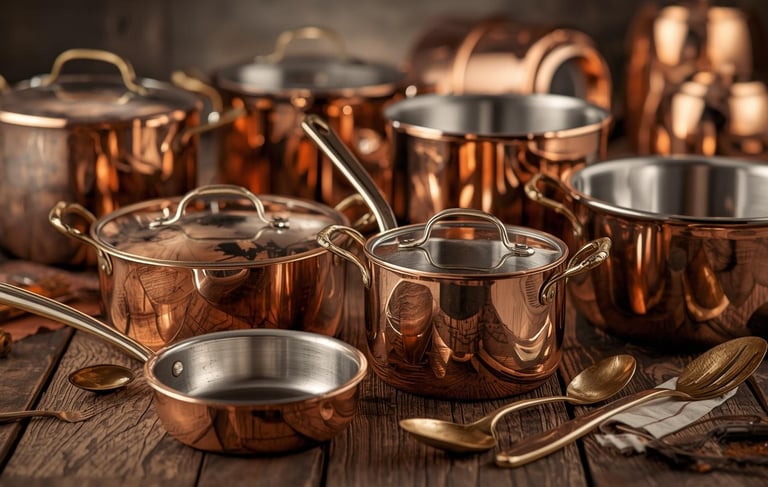

Heat Conductivity: Excellent — heats up and cools down quickly.
Best For: Delicate sauces, candy-making, and tasks requiring precise temperature control.
Watch Out: Reacts with acidic foods and requires regular polishing. Often lined with stainless steel to prevent reactivity.
Aluminum: Lightweight and Responsive
Aluminum cookware is a popular and practical choice for both home cooks and professionals due to its excellent heat conductivity, affordability, and lightweight design. Aluminum heats quickly and evenly, reducing the risk of hot spots that can cause uneven cooking or burning. This makes it ideal for tasks that require consistent temperature control, such as sautéing, boiling, or simmering. Its responsiveness allows cooks to adjust heat levels with precision, which is especially useful when preparing delicate sauces or quick-cooking dishes. Additionally, aluminum is significantly lighter than other metals like cast iron or copper, making it easier to handle, especially when lifting full pots or pans.
Modern aluminum cookware often comes with nonstick coatings or anodized finishes, which improve durability, resist corrosion, and prevent food from sticking. Hard-anodized aluminum offers a tougher surface that’s scratch-resistant and compatible with a variety of cooking techniques. Aluminum is also budget-friendly, offering high performance at a lower cost compared to premium materials. While it’s not naturally non-reactive, most aluminum cookware is treated or lined to prevent interaction with acidic foods. Overall, aluminum cookware delivers reliable performance, ease of use, and great value — making it a smart, versatile option for everyday cooking.
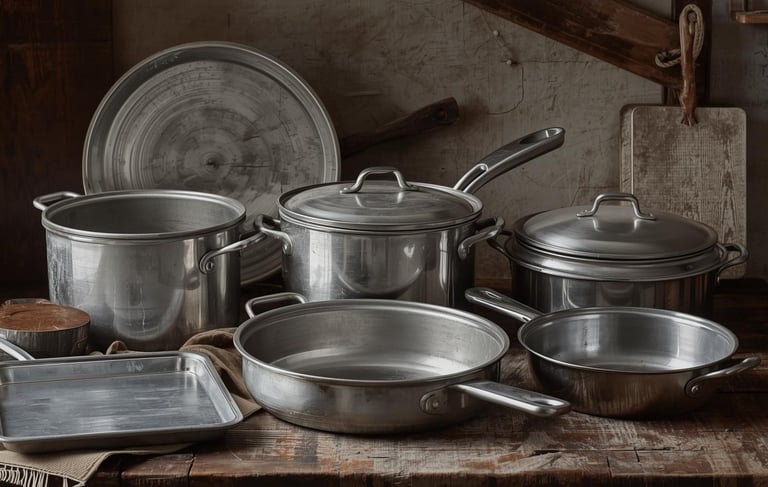

Heat Conductivity: Very good — second only to copper.
Best For: Sauté pans, baking sheets, and budget-friendly cookware.
Watch Out: Soft and prone to warping; can react with acidic foods unless anodized or clad.
Stainless Steel: Durable and Versatile
Stainless steel is a powerhouse in the kitchen, prized for its exceptional durability and adaptability. Resistant to rust, corrosion, and staining, it stands up to high heat, heavy use, and acidic ingredients without warping or degrading. Its non-reactive surface makes it ideal for cooking a wide range of foods—from searing meats to simmering tomato-based sauces—without altering flavor or color.
Versatility is where stainless steel truly shines. It’s compatible with all cooktops, including induction, and often oven-safe, making it perfect for stovetop-to-oven recipes. Many stainless steel pans feature an aluminum or copper core sandwiched between layers of steel, enhancing heat distribution and responsiveness. Whether you're a beginner or a seasoned chef, stainless steel cookware offers a reliable, professional-grade experience that can handle nearly any culinary task.

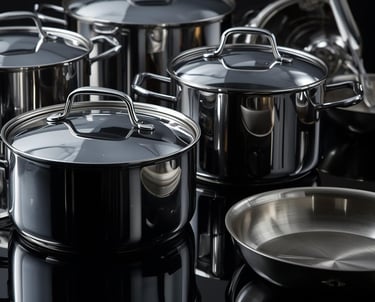
Heat Conductivity: Poor on its own, but often layered with aluminum or copper cores.
Best For: Browning, searing, and deglazing — great for everyday cooking.
Watch Out: Uneven heating if not clad; food can stick without proper technique.
Cast Iron: The Heat Retention Champ
Cast iron cookware is widely celebrated as one of the best choices for cooking due to its unmatched durability, versatility, and heat retention. Once heated, cast iron maintains a consistent temperature, making it ideal for searing, frying, baking, and slow cooking. Its ability to hold high heat allows for perfect browning and caramelization, whether you're crisping chicken skin, searing steaks, or baking cornbread with a golden crust. Cast iron’s thick walls distribute heat evenly, reducing hot spots and ensuring uniform cooking across the surface. Over time, a well-seasoned cast iron pan develops a natural nonstick layer, enhancing flavor and making cleanup easier without synthetic coatings. It’s also oven-safe and can transition seamlessly from stovetop to oven, perfect for dishes like frittatas, casseroles, or skillet-roasted vegetables.
Cast iron is incredibly durable — often lasting generations — and improves with use. It’s compatible with all heat sources, including induction, and can even be used over open flames, making it a favorite for both indoor and outdoor cooking. While it requires some maintenance to prevent rust and preserve seasoning, the payoff is a reliable, high-performance tool that elevates everyday meals. For cooks who value tradition, resilience, and flavor, cast iron remains a timeless kitchen essential. For more information, please check out my blog on the “Cast Iron Skillet” in the blog section.
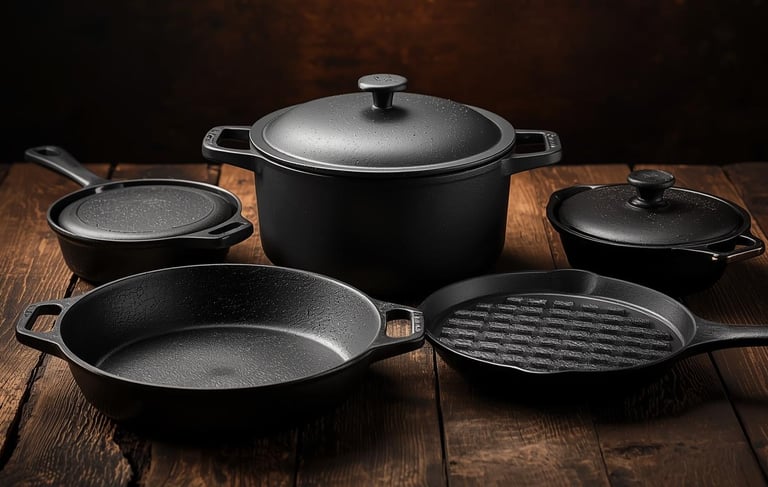

Heat Conductivity: Slow to heat, but retains heat exceptionally well.
Best For: Searing steaks, baking cornbread, and slow-cooked dishes.
Watch Out: Heavy, requires seasoning, and can rust if not cared for properly.
Nonstick: Easy Does It
Non-stick cookware is a smart and convenient choice for everyday cooking, offering ease of use, quick cleanup, and healthier meal preparation. Its defining feature — a slick, nonstick surface — allows food to release effortlessly without clinging to the pan, making it ideal for cooking delicate items like eggs, pancakes, fish fillets, and crepes. Because food doesn’t stick, you can use less oil or butter, which supports lower-fat cooking and cleaner flavors. Non-stick pans also heat up quickly and evenly, helping you maintain control over temperature and avoid burning or uneven results. This makes them perfect for tasks that require gentle heat and precision, such as sautéing vegetables or reheating leftovers.
Cleanup is another major advantage. Food residue wipes away easily, and most non-stick cookware is dishwasher-safe, saving time and effort. Lightweight construction adds to their appeal, making them easy to handle, especially for quick meals or multitasking in the kitchen. Modern non-stick coatings are more durable and scratch-resistant than ever, often reinforced with ceramic or titanium for added longevity. While they’re not suited for high-heat searing or metal utensils, non-stick pans excel in convenience, efficiency, and versatility — making them a go-to option for busy cooks who value simplicity without sacrificing performance.

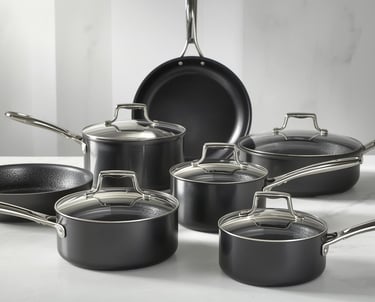
Heat Conductivity: Depends on the base (usually aluminum).
Best For: Eggs, pancakes, and low-fat cooking.
Watch Out: Can’t handle high heat; coating degrades over time and may release fumes if overheated.
Ceramic and Glass: The Oven Stars
Ceramic and glass cookware are true stars of the oven, prized for their ability to deliver consistent, gentle heat and stunning presentation. These materials excel at retaining and evenly distributing heat, making them ideal for baking casseroles, lasagnas, gratins, and desserts like cobblers or bread pudding. Unlike metal pans, ceramic and glass don’t react with acidic ingredients, so they’re perfect for tomato-based dishes or fruit-filled bakes. Their nonporous surfaces resist staining and odors, ensuring clean flavors and easy cleanup.
Ceramic often features attractive glazes and colors, allowing dishes to go straight from oven to table with elegance — no need to transfer to serving ware. Glass cookware offers the added benefit of visibility, letting you monitor browning and bubbling without opening the oven door. Both materials are excellent for slow, steady cooking, helping food retain moisture and develop rich, layered flavors. While they’re not suited for stovetop use or sudden temperature changes, their oven performance is unmatched in terms of reliability and aesthetic appeal. Whether you're roasting vegetables, baking a creamy mac and cheese, or crafting a bubbling fruit crisp, ceramic and glass cookware bring warmth, beauty, and precision to your kitchen — making them indispensable tools for oven-based cooking.
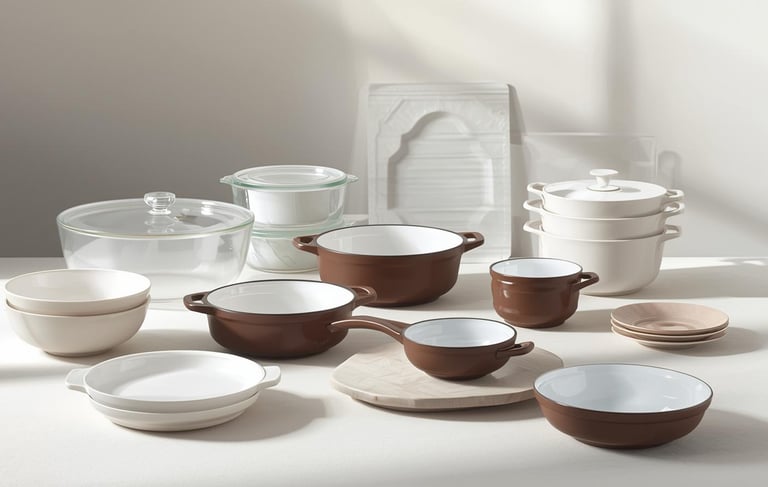

Heat Conductivity: Poor, but they distribute heat evenly.
Best For: Baking casseroles, pies, and lasagna.
Watch Out: Fragile and not ideal for stovetop use.
Why It Matters
Your choice of cookware directly impacts the flavor, texture, and consistency of your food. Different materials conduct heat differently — copper and aluminum heat quickly and evenly, while cast iron retains heat for steady cooking. Non-stick surfaces prevent sticking and require less oil, ideal for delicate items like eggs or fish. Stainless steel offers durability and a safe, non-reactive surface for acidic foods. The right pan ensures even cooking, prevents burning, and supports the technique you’re using, whether it’s searing, simmering, or baking. Choosing cookware that matches your recipe and cooking style elevates your results from good to exceptional.

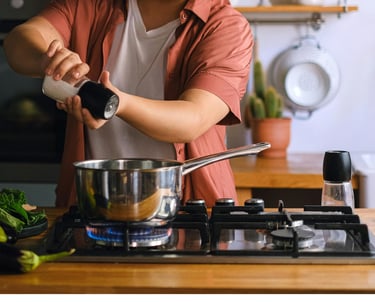
Even Heating prevents hot spots that can burn food.
Heat Responsiveness gives you control — crucial for sauces and delicate proteins.
Retention is key for dishes that need consistent heat, like braises or stews.
Reactivity affects flavor and safety — acidic foods can leach metal ions from reactive pans.
Final Tip: Clad Cookware
For the best of all worlds, many chefs use clad cookware. Clad cookware is a top choice among chefs and serious home cooks because it combines the best properties of multiple metals into a single, high-performance pan. Typically, clad cookware features an aluminum or copper core sandwiched between layers of stainless steel. This layered construction offers a powerful trifecta: aluminum or copper provides excellent heat conductivity, ensuring fast, even heating across the cooking surface, while stainless steel adds durability, corrosion resistance, and a non-reactive cooking surface that’s safe for all types of food.
The result is cookware that heats quickly and evenly, minimizing hot spots and allowing for precise temperature control — essential for tasks like searing, sautéing, or simmering delicate sauces. At the same time, the stainless steel exterior resists warping, scratching, and staining, making it suitable for high-heat cooking and compatible with induction cooktops. It’s also dishwasher-safe and easy to maintain.
Clad cookware is versatile enough to go from stovetop to oven, and its balanced weight makes it comfortable to handle. Whether you're browning meat, deglazing a pan, or preparing a reduction, clad pans offer the responsiveness of aluminum with the strength and safety of stainless steel. For chefs who demand performance, reliability, and longevity, clad cookware delivers the best of all worlds.


Acaiguy Cooks
Explore recipes and tips for home cooking.
© 2025. All rights reserved.
Questions, comments, suggestions? We would like to hear from you!
